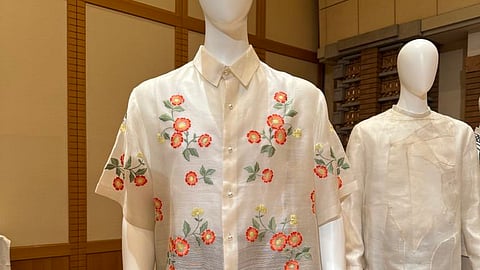
- NEWS
- the EDIT
- COMMENTARY
- BUSINESS
- LIFE
- SHOW
- ACTION
- GLOBAL GOALS
- SNAPS
- DYARYO TIRADA
- MORE

On the occasion of the 126th anniversary of the declaration of Philippine independence, the Embassy of the Philippines in Japan and Sentro Rizal Tokyo presented The Barong Tagalog Exhibition: Weavefining Philippine Culture, Tradition and Fashion in Menswear on 12 June, during the Philippine Independence Day Reception, at the Fuji Ballroom of the Imperial Hotel in Tokyo.
The participating designers were Barge Ramos, Steve de Leon, Renee Salud, Rajo Laurel, Randy Ortiz, Puey Quiñones, RJ Santos, Kelvin Morales, Joey Samson, Ched Dalogaog of Ched Studio, Philip Rodriguez from Cebu and Wilson Limon of the NiñoFranco brand from Davao.
A barong Tagalog by JC Buendia from the collection of the Aquino family worn by late Benigno “Noynoy” Aquino III, one of the most highly regarded Philippine presidents, was also on display.
The established designers retained the more traditional aspects of the barong Tagalog while the younger ones revamped the shape, fabric, color and embroidery of the Filipino men’s wardrobe staple.
As per the production notes, “the barong Tagalog can trace its origin to as far back as the 16th century, with the very first iteration of the barong Tagalog combining elements from both the pre-colonial native Filipino and colonial-style Spanish clothing, made with nipis or thin fabrics such as piña or abaca fabrics in bold, playful colors.
“In 1953, then Philippine President Ramon Magsaysay known as the Champion of the Masses” democratized the barong Tagalog and brought it to the common people by wearing one during his inauguration. Since then, it has become the preferred formal attire of succeeding Philippine presidents. A presidential decree in 1975 designated the barong Tagalog as the official Philippine national attire.
“Today, the barong Tagalog is no longer worn just by presidents but by most Filipino men, as formal, office and everyday wear. Many Filipino grooms have opted to wear the barong Tagalog on their weddings as well. Short-sleeve versions have become popular and practical alternatives to the more formal long-sleeve version in fabrics such as silk cocoon, cotton and other blends,” the production notes stated.
Exhibit
Tetta Ortiz Matera, one of the foremost Filipino supermodels now based in Japan, organized the events entirely in cooperation with the Philippine Embassy.
“The barong Tagalog exhibition is a continuation of the efforts of the Embassy of the Republic of the Philippines in Japan, led by Ambassador Mylene J. Garcia-Albano, to promote Philippine fashion that is rooted in Philippine culture, made in part with handwoven fabrics handcrafted by artisans from different parts of our country,” Matera says via e-mail.
Last year, the terno was featured in a similar exhibit, with a day-long presentation and talk by Len Cabili, an advocate for Moro hand-weaving communities and the person behind the local brand, Filip+Inna.
Like the 2024 exhibit, the 2023 exhibit was also held during the reception hosted by the Philippine ambassador, with foreign dignitaries, the diplomatic community, Japanese government officials, trade partners, Japanese friends and other VIPs in attendance.
“For this year, the ambassador suggested that we feature the barong Tagalog since most of the guests to the official reception are men. So, I selected designers who were experts in creating barong Tagalogs, all of whom I have also worked with in the past either in a model or a mentor capacity and who also happen to be friends of mine,” Matera said. “I chose a mix of designers whose careers span decades and designers who have broken out in the past decade; they all have different takes on the barong Tagalog from the traditional to the contemporary, formal to casual and conservative to more playful, youthful designs.”
“The response was very positive. Some of the guests were asking if the barong Tagalogs were sold in a store in Japan because they were interested to buy. They were very impressed with the delicate fabrics and the intricate embroideries and detailing applied to all the barong Tagalogs on exhibit,” Matera revealed.
She is also brimming with optimism that future Filipino fashion events in Japan will be received just as well.
“We have such an enormous pool of fashion design talents, and I believe events such as runway presentations and exhibits are a great way to introduce them to the Japanese and expats living in Japan,” Matera further said. “In addition to these showcases, I hold pop-ups through my company, LIT Fashion Consultancy. These pop-ups provide an opportunity for some of our local brands to sell their products directly to certain segments of the Japanese market and expat community.”
Matera continues to work tirelessly on organizing more of these pop-up stores and producing other types of projects which will not only bring more awareness to globally competitive Filipino brands but also bring guaranteed sales for their businesses.
“I hold pop-ups three times a year, two on my own and one with a multi-brand store here in Tokyo. In between I have projects like the one I just did with the Philippine Embassy here in Tokyo. I do the pop-ups to support our local brands,” Matera says. “especially the young designers with strong and clear branding, great design concepts and high-quality products who understand how the global fashion market works. These projects keep me busy throughout the year.”
Living in Japan has widened Matera’s perspective or appreciation for Philippine heritage and culture, especially on clothing and fashion.
“Having been exposed to a multitude of brands from all over the world through my participation with Tokyo Fashion Week and daily exposure to fashion living in Tokyo, I can truly say that our roster of designers, particularly the young ones with exciting brand concepts who take inspiration from our rich heritage and culture, has compelling fashion stories to tell that are worth sharing in the fashion retail landscape not just in Japan but the rest of the world,” she enthused.
